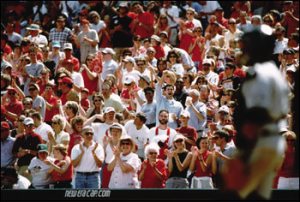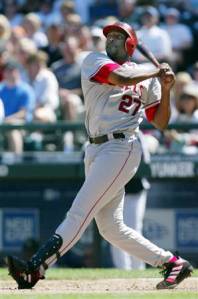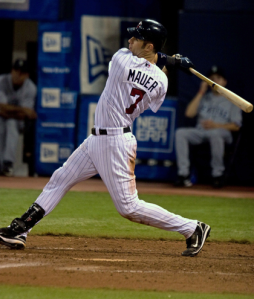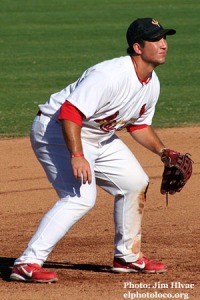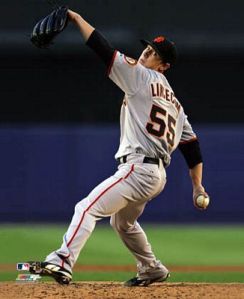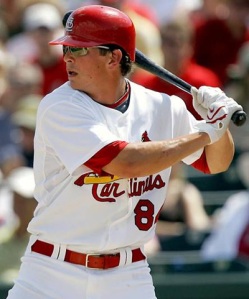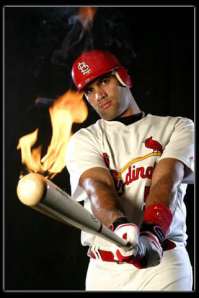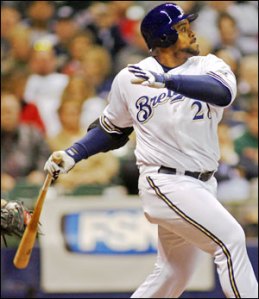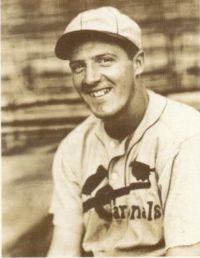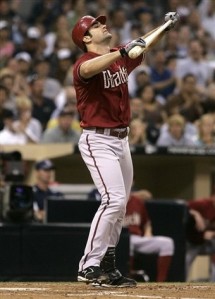
Don't despair D-Backs, you're the best of the worst.
Though long regarded as the little brother of the American League, the NL has quietly improved over the past few years and captured last year’s World Series thanks to the dominating Philadelphia Phillies. Though they still can’t win an All-Star game (apparently they count for something now), the National League has more quality teams than the AL and will look to go back-to-back in the 2009 Fall Classic.
NL West: Yikes! Winning this division is a lot like winning VH1’s Tool Academy–it doesn’t count for much. Three-and-out in the first round of the playoffs for whichever one of these teams sucks the least.
1. Arizona Diamondbacks (86-76): Flush with young talent, the D-Backs should capture this weak division with continued growth from Chris Young, Stephen Drew and Justin Upton. Also boasting one of the best pitching staffs in the NL, including the 1-2 punch of Brandon Webb and Dan Haren, the snakes should slither in the playoffs after faltering down the stretch last season.
2. LA Dodgers (84-78): The Dodgers could move up or down in this division, depending on where Manny Ramirez ends up. The team lost starters Derek Lowe and Brad Penny to free agency and were so desperate for pitching that they invited Jeff Weaver to spring training (yes Mariner’s fans, that Jeff Weaver). Joe Torre may be a magician, but he just doesn’t have enough cards up his sleeve to pull this one off.
3. San Francisco Giants (79-83): Arguably the most improved team in the NL West, the Giants have all the pitching (Tim Lincecum-Randy Johnson-Matt Cain) to win, but with the heart of the lineup consisting of such fearsome sluggers as Randy Winn, Aaron Rowand and Bengie Molina might have a difficult time scoring enough runs to support their staff. Rumor has it Barry Bonds is still available…
4. Colorado Rockies (74-88): This team isn’t particularly bad, but they aren’t particularly good either. They traded away their most consistent offensive threat, Matt Holliday, for some pieces off Billy Beane’s scrap heap in Oakland, and mostly treaded water in the off-season. Expect consistent mediocrity throughout the year. Sorry Dave.
5. San Diego Padres (64-98): Will challenge for the worst team in baseball but little else. The Padres should trade Jake Peavy before the season is over, leaving the pitching staff in the capable hands of Chris Young, Josh Banks, Cha Seung Baek, Mark Prior? Don’t feel too bad for San Diego fans, they can always console themselves with a cold one on the beach soaking up the sunshine…KC Royals fans, not so much.
NL Central: This division has more teams than any other, so that’s something. Three of these teams could compete for a playoff spot, but it is unlikely that anyone will challenge the Cubs for the division.
1. Chicago Cubs (96-66): Sure the Cubbies will win the division, but everyone knows that they will choke in the postseason, so does it even really matter? This team is better than last years squad which won 97 games, thanks to the addition of Milton Bradley and a full healthy year from Rich Harden (why does everyone laugh when I say that?) Lou Piniella’s team is the class of the National League, but have yet to prove it in October. Will this be the year the curse ends? No.
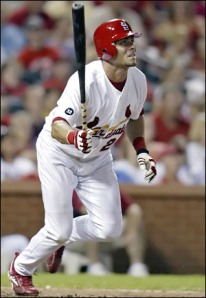
Can Ankiel lead the Cards to the playoffs?
2. St. Louis Cardinals (87-75): Any team with Albert Pujols has a chance to contend, as proved by last year’s overachieving Cardinals. The offense will be one of the better top-to-bottom in the NL with A-Pu, Ryan Ludwick and Rick “The Natural” Ankiel. The pitching staff is the real question mark, and counting on a full season from Chris Carpenter is kind of liking counting on John Rocker and Jesse Jackson collaborating on a book–unlikely.
3. Houston Astros (85-77): Houston was making a strong push for the playoffs last year before hurricane weather forced them to play their home games in Milwaukee (I looked it up, it’s not in the state of Texas). The Astros should be a solid squad once again, assuming the weather holds up and Miguel Tejada doesn’t end up in jail. Mike Hampton returns to the home of his 22-win season, but his year should be considered a success if he manages to throw 22 pitches.
4. Milwaukee Brewers (79-83): The Brew Crew were the surprise of the NL last year, making it to the playoffs for the first time since 1982. Don’t expect them to go back-to-back though, after losing ace pitchers CC Sabathia and Ben Sheets to free agency. Prince Fielder and Ryan “Brains and” Braun are the meat (or tofu in the case of Fielder, a vegan) of a good offense, but it won’t be enough for them to repeat last year’s success.
5. Cincinnati Reds (78-84): The Cincinnati Reds have the look of a team that will be good in a few years, chock full of young talent like Jay Bruce and Edison Volquez, but they also have the look of a team that will struggle mightily this year. Granted they will be better than the Bengals, but not by much.
6. Pittsburgh Pirates (68-94): The Pirates, currently in year 15 of a 30-year rebuilding plan, will stink worse than two-month-old milk. At least it’s a scenic town…
NL East: Probably the best division in the the National League, the NL East has four teams with a shot at making the playoffs. Problem is, only two of them will get in…let the fighting commence! (* denotes wildcard winner)
1. New York Mets (95-67): No really, they won’t collapse down the stretch this season. Thanks to the additions of JJ Putz and Francisco Rodriguez, New York should have just enough talent to eek out a win in this tough division. With potential Cy Young winner Johan Santana and the dynamic duo of Jose Reyes and David Wright the Metropolitans will be a handfull come playoff time. Do I smell a Subway Series brewing?
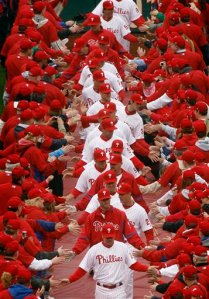
Can the Phillies remain top dog in the NL East?
2. Philadelphia Phillies* (93-69): The defending champs bring back the bulk of last year’s team and should be considered a serious threat to win it all again. Chase Utley and Ryan Howard lead the offense, while Cole Hamels and septuagenarian Jamie Moyer key the pitching staff. This division race should go down to the end of the season and will decided by the bullpens (hint: don’t expect another perfect year from Brad Lidge).
3. Florida Marlins (91-71): Despite selling off their top talent seemingly every year, the Marlins are still a darkhorse to win the division. Lots of young talent on both sides of the ball–led by the pitching staff of Josh Johnson-Anibal Sanchez-Ricky Nolasco and the keystone combination of Hanley Ramirez and Dan Uggla, will power the fish to a surprising record. Keep on eye on young centerfielder Cameron Maybin, 2009 may be his coming out party–of the baseball variety that is.
4. Atlanta Braves (84-78): The Braves had a difficult off-season, losing out on free agents Rafael Furcal and Ken Griffey Jr. and allowing John Smoltz to jump to Boston. The pitching staff was bolstered by the additions of Derek Lowe and Kenshin Kawakami and Atlanta signed fan favorite Tom Glavine hoping that he still has something to offer (besides a startlingly resemblance to Bob Saget). Not a whole lot to get excited about on the offense, besides Chipper Jones and Brian McCann. Look for Bobby Cox to increase the all-time record for ejections substantially this season.
5. Washington Nationals (70-92): The NL version of the Mariners, the Nats have a bigger collection of washed up stars than the Surreal Life. The addition of Adam Dunn was a pleasant surprise (who joins a growing list of Cincinnati Reds’ castoffs including Austin Kearns, Wily Mo Pena, Cory Patterson and Dmitri Young–who, if they aren’t good enough for the Reds, well, somethings are better left unsaid) but their “big” pitching acquisition of Daniel Cabrera (8-10, 5.25 ERA in 2008) leaves a little something to be desired. It’s hard to tell which is worse: the relationship between Democrats and Conservatives on Capitol Hill or the Washington Nationals. Cover your eyes Nationals’ fans, it’s going to be a long year.
Coming Soon: Playoff Previews and World Series Winner!!
Filed under: Baseball | Tagged: 2009 forecast, Arizona Diamondbacks, chicago cubs, Colorado Rockies, giants, New York Mets, NL Central, NL East, NL West, padres, philadelphia phillies, roy hobbs, St Louis Cardinals, surreal life, tool academy | 5 Comments »








